| Author | Message | ||
| Laryn Christley (Barn_owl)
Registered Member Username: Barn_owl Post Number: 458 Registered: 10-2006 Posted From: 72.66.162.174 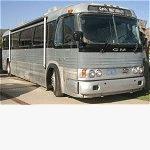 Rating: N/A |
I didnít know that simultaneous application of the service brake and the parking brake (spring brake) was something one shouldnít do. I needed to replace my air relay valve and while doing the research I kept on seeing anti-compounding valves mentioned in addition to the regular valves. While reading through the Bendix web site I read that applying both the service brake and the parking brake at the same time (without an anti-compounding valve) could damage the brake components. I had never read or heard anything about this before so I thought I would bring it up here. The fleet mechanics where I work know about it and say they have seen the damage it can cause. I guess I am lucky because I have applied full brake pressure while the spring brakes were set and the best I can tell I didnít break anything. The anti-compounding valve eliminates this potential problem but I do not have an anti-compounding valve on my bus. I will just be more careful in the future. Does anyone else know about this? (Message edited by barn_owl on July 04, 2008) (Message edited by barn_owl on July 04, 2008) | ||
| Jack Conrad (Jackconrad)
Registered Member Username: Jackconrad Post Number: 781 Registered: 12-2000 Posted From: 76.3.173.51 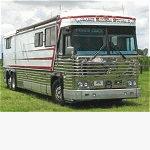 Rating: N/A |
I think applying both parking and service brake at the same time can apply more pressure to the brake system than it was designed for. This coulg result in bent or broken components I think DD3 applies 85 psi through park circuit. 85 PSI x 30 sq. in. diaphragm=2550 PSI. A firm service brake application of 60 PSI x 30 sq.in. diaphragm=1800 PSI. 2550 + 1800 =4350 PSI applied to brake components. If my thinking is incorrect (would not be the first time), please explain correct answer. Jack | ||
| Don Evans (Doninwa)
Registered Member Username: Doninwa Post Number: 131 Registered: 1-2007 Posted From: 208.81.157.90 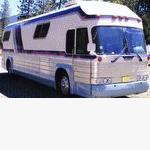 Rating: N/A |
Interesting question. I could be all wet (frequently) but I am under the impression that with my DD3 brakes that if you hold the brakes very hard while you apply parking brakes that you may not be able to overcome the pressure to unlock them. Sometimes there is just no way not to hold some brake while applying parking brakes. I suppose I should release the pressure on the treadle at the same time I pull the knob. That is kind of a natural thing to do, but not sure of the required timing. Don 4107 | ||
| George M. Todd (George_mc6)
Registered Member Username: George_mc6 Post Number: 485 Registered: 8-2006 Posted From: 207.231.75.253 Rating: N/A |
IMNSHO, Everything said here so far is correct! Our picky poster on another subject may chime in and say that 2550, and 4350 are total pounds of force and not psi, so I will beat him to it. I'm not real proud of me for saying that either, because the bottom line is that the thought and the figures are right! Many of us have DD3 equipped buses with a tag which reads "Make a 100 pound brake application to realease parking brake," and have done so for YEARS without causing damage. There have also been many posts over the years about DD3 parking brakes failing to release, many of which are caused by too much service brake application when the parking brake was applied to hot drums. After the drums cool off and contract, it takes a LOT of force to overcome the strain on the lock mechanism to get a release. So, just don't STAND on the service brake when you pop the knob, and all's well. (I didn't know that when I bought my bus, so I guess I was lucky, also it releases without a service application, whatever that's worth.) Two final thoughts: When I bought my bus from a used bus dealer, it didn't stop well, to the point that the driver (they won't let you drive the bus) overran the driveway on the way back, and had to back up to turn in. The problems turned out to be a leaking oil seal on the left tag, so the drum and shoes were oiled, a missing yoke on the right tag, so the rod wasn't even connected to the arm, and the point of this comment, a crack in the right drive slack adjuster, which allowed the arm to go to the end of its travel without applying the shoes. The governor had been set up to unload at 150, in an attempt to get more braking effort? As there was oil all over the left tag tire and the wheel well, it was obvious that it had been leaking for a long time. The right tag drum was really rusty, and the shoes were brand new, so it appeared to not have been working for a long time either. I don't know if they turned the governor up from 120 to 150 before or after the right slack adjuster broke, but the left arm is still working properly 23 years later, after being subjected to a whole lot of abuse by the tour company for several years! Second: I think the anti-compounding valve is mostly to prevent skidding when an undesired emergency occurs. If an emergency hose breaks on a set of loaded doubles, one axle braking on the rear double will take a looong time to stop the rig, when the driver sees trouble and steps on the service brake, the axle(s) with the emergency application would be the only one(s) to lock. So, you add anti-compounding, and you get a nice controlled stop. Whew, Happy Fourth, George | ||
| Jack Conrad (Jackconrad)
Registered Member Username: Jackconrad Post Number: 782 Registered: 12-2000 Posted From: 76.3.173.51  Rating: N/A |
George, I think it was Ewen "buswarrior" that told me that the DD3 will release without a service brake application IF the air system has not lost enough pressure to allow the locking rollers to engage (about 65 PSI). Anything above 65 PSI, the parking brake diaphragm is applying the brakes. Once the rollers have engaged, it then takes a brake application to release the rollers so the spring can move the rollers back away from the shaft. Jack This applies to DD3 brakes only. | ||
| FloridaCliff (Floridacracker)
Registered Member Username: Floridacracker Post Number: 385 Registered: 7-2004 Posted From: 68.202.123.208 Rating: N/A |
Jack, I have seen this with my DD3's all the time. If I wait 5-10 seconds after releasing the parking brake I will know they have released, as I start to roll forward or backward...... Cliff | ||
| George M. Todd (George_mc6)
Registered Member Username: George_mc6 Post Number: 487 Registered: 8-2006 Posted From: 207.231.75.253 Rating: N/A |
Jack, I think somebody is confused, because air pressure is required to keep the locking mechanism RELEASED on our buses. In the release position, (knob depressed) pressure is applied to the lock line, and there is no pressure in the parking diaphragm. In the park position, air is released from the lock line, and regulated pressure is applied to the parking diaphragm. If that pressure is lost for any reason, the lock mechanism mechanically holds the brakes applied. An option was installed on some buses which requires a 100 psi foot pedal application to release the parking brake after the knob was depressed, buses without this option will release immediately. Some require a foot pedal application to overcome the bind on the locking mechanism, from having a heavy foot pedal application when the parking brake was applied. Maybe he was talking about the system automatically applying the parking brakes at 65 psi main reservoir pressure, as in an air leak? (Message edited by George Mc6 on July 04, 2008) | ||
| Buswarrior (Buswarrior)
Registered Member Username: Buswarrior Post Number: 1319 Registered: 12-2000 Posted From: 76.68.121.24 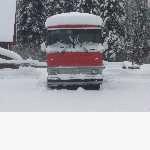 Rating: |
Hello. This thread is going in horrible directions.... First on the DD3: You can't compound a DD3. It is valved to prevent this. Second: Jack remembers correctly. If the air pressure in the parking tank drops below the regulator setting, which is typically 85 lbs, the locking rollers in the DD3 will bind on the shaft as the pressure exerted "from behind" eases. To ensure a proper release, the manufacturer recommends a full pressure service application to unbind the rollers so that they may be retracted by the locking collar. It is not an "option", it is the way they work. The stock dashboard air gauge is no indicator as to the pressure in the park tank, so the driver has no way of knowing what they have, or whether they have a clean, full release. Just squeeze the brake pedal on release and be done with it. Ok, now for anti-compounding in spring brake systems... This is another rare and mystical thing from a relatively short period in antiquity when air systems and spring brakes were in their relative infancy. It was possible to compound the spring and service brake forces, to the potential harm of the mechanical brake components. In short order, the valving of air systems was designed with anti-compounding features, basically, if you apply the service brakes while the parking brake is set, the air pressure is proportionally directed into the spring release circuit, thereby cancelling the compounding effect. Compounding was over-emphasized from the beginning by trainers, and continues to be mentioned, when it is irrelevant to the modern equipment. For the most part, it is harmless. Certainly there is no problem with laying a foot on the brake pedal. Best not to be standing on it, if you have a system capable of compounding. If something does break, it wasn't the best to begin with. For those with buses from the period of antiquity, and I'm not sure when prior to 1975 that might be, you want to know whether your heritage relay valves incorporate anti-compounding or not. happy coaching! buswarrior | ||
| George M. Todd (George_mc6)
Registered Member Username: George_mc6 Post Number: 489 Registered: 8-2006 Posted From: 207.231.75.253 Rating: N/A |
BW, I have to disagree with you on a couple of things. 1. MOST DD3 buses will release from a parking application just by pushing the knob, including mine. I'm not going to speak for yours. There ARE many buses out there with a tag next to the DD3 know which reads "To release parking brake make a 100 psi foot pedal application." This was an option to be ordered by the individual bus company. Buses with this tag will not release until the brake pedal is depressed after the knob. This has been posted recently here. 2. The DD3 lock rollers are either applied or released, depending upon the inversion valve. Yes, the inversion valve will trip at about 85 psi. and cause a full emergency application, but the lock rollers won't start to prevent a RELEASE until way below 85 psi. 3. Air up your bus, have someone release the brakes, then make a full treadle application, and pop the knob while you are standing at the rear. The only release you will hear is air out of the DD3 lock line, you will not hear the drive axle service brakes release, because they don't. 4. Many of us have replaced DD3s and handbrakes with springs, and I know of none that have broken foundation brake components! 5. As I said before, the only reason not to stand on your treadle when popping the knob, is that you might not get a release. 7. Look at the Bendix web site! George | ||
| Buswarrior (Buswarrior)
Registered Member Username: Buswarrior Post Number: 1320 Registered: 12-2000 Posted From: 76.69.140.214  Rating: N/A |
George, if you are going to present yourself as an expert, it would best if you were accurate with your information and did not pepper your writings with jargon to hide the bits you don't know. Go back and read the posts other than your own, you've introduced all manner of confusion to this topic. Tripping the inversion valve? Please expand on what this means and what it has to do with the topic at hand? If you were enjoying a beverage at the time of your writing, or if you are deteriorating, naturally, all is forgiven! happy coaching! buswarrior | ||
| George M. Todd (George_mc6)
Registered Member Username: George_mc6 Post Number: 491 Registered: 8-2006 Posted From: 207.231.75.253 Rating: N/A |
BW, You are the one who posted "this thread is going in horrible directions" I will hereby suggest you practice what you preach, AND not be too quick to criticize! For your information, and to avoid your saying I don't know what I am talking about, the inversion valve is what controls the application and release of DD3 parking brakes. It also senses parking reservoir pressure, and triggers an emergency application when the pressure falls below its trip point. It is controlled by the parking/emergency knob, but cannot be overridden by it. (Holding the knob down with low air pressure will not cause a release.) I will suggest to you again to look at the Bendix web site, preferably before you hurry to reply, and do me a favor and show me how our buses are "valved to prevent compounding." You also don't mention doing as I suggested, which would quickly and easily demonstrate that a service application remains on the drive axle when a parking application is made. From your post, it sounds like you consumed too much beverage several hours previous, and weren't feeling well when you posted! So present FACTS, and I will gladly professionally discuss brake systems with you, (after you find out what an inversion valve is, and trust me, your bus and mine had them from the factory!) George | ||
| Buswarrior (Buswarrior)
Registered Member Username: Buswarrior Post Number: 1321 Registered: 12-2000 Posted From: 76.69.140.214  Rating: N/A |
I am dumbfounded, and will withdraw. happy coaching! buswarrior | ||
| Ian Giffin (Admin)
Board Administrator Username: Admin Post Number: 1101 Registered: 7-1997 Posted From: 24.239.7.250  Rating: N/A |
Ah, well... Ace & Fred... er, uh, sorry, make that George & BW. Try to remain calm... or I'll have to come over there and step on your treadles so hard it will flip your S-cams over. And we all know what our brakes are like with our S-cam flipped, don't we? Now... group hug! :~) Ian www.busnut.com | ||
| George M. Todd (George_mc6)
Registered Member Username: George_mc6 Post Number: 496 Registered: 8-2006 Posted From: 207.231.75.253 Rating: N/A |
There's no hard feelings on this end! I didn't "win" either, I'm only trying to get information out. G | ||
| Buswarrior (Buswarrior)
Registered Member Username: Buswarrior Post Number: 1322 Registered: 12-2000 Posted From: 76.69.140.207  Rating: N/A |
Hello George. In order to help our viewers, would you please explain/expand upon this tripping of an inversion valve that you keep repeating? And the variations depending on styles/vintages of plumbing? happy coaching! buswarrior | ||
| H3-40 (Ace)
Registered Member Username: Ace Post Number: 869 Registered: 10-2004 Posted From: 216.9.250.111  Rating: N/A |
And here I thought I was being pretty good lately!  Ace | ||
| FAST FRED (Fast_fred)
Registered Member Username: Fast_fred Post Number: 401 Registered: 10-2006 Posted From: 208.100.193.33 Rating: N/A |
And I'm sitting on my hands! FF | ||
| RJ Long (Rjlong)
Registered Member Username: Rjlong Post Number: 1391 Registered: 12-2000 Posted From: 67.181.166.160 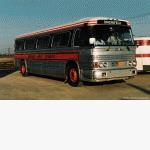 Rating: |
IIRC, inversion valves are found on coaches that have dual air systems, be they DD3s or Spring Brakes. Their function, again IIRC, is to "flip" one way or the other to provide some service braking capability should there be a catastrophic air loss in either the primary or secondary air tank. Limited service brake is available until system air pressure drops to the point the parking/emergency brake sets automatically. Also, IIRC, there should be enough air in the parking brake circuit tank to allow an operator to push in and hold the parking brake button down while he moves the coach a short distance (like onto the shoulder), but once the button's released after this, the coach is dead in the water. Ace's H3 should have one, Fred's (and my) 4106 do not. I think the dual-air requirements came into effect around 1977 or 1978, give or take a little. Again, this is IIRC, it's been awhile since I taught this stuff. FWIW & HTH. . .  | ||
| John Lacey (Junkman42)
Registered Member Username: Junkman42 Post Number: 44 Registered: 3-2007 Posted From: 66.82.9.87  Rating: N/A |
I have it now! Push the yellow button and if it goes and stops all is well? I am to old to follow all of this stuff, I guess that is why I can not fly anymore. LOL John | ||
| Mike Eades (Mike4905)
Registered Member Username: Mike4905 Post Number: 170 Registered: 12-2000 Posted From: 68.200.183.92 Rating: N/A |
RJ My 75 buffalo has the system. My new prevost has it and my new MCI models all have the new system. You can't oveeride except with an emergency valve mounted way out of the way. Mike | ||
| George M. Todd (George_mc6)
Registered Member Username: George_mc6 Post Number: 499 Registered: 8-2006 Posted From: 207.231.75.253 Rating: N/A |
Sorry not to get back into the "fray" sooner, but work being the crabgrass in the lawn of life, I had to do some weeding. RJ said it well for me though, when inversion valves operate, they take air from one side, and put it on the other, as in releasing pressure on the lock line, and applying pressure to the park/emergency diaphragms. Call it trips, flips, or whatever, the operation is just as quick when the valve does it itself, as when the knob is pulled. This is why I caution about adjusting drive axle brakes, because of the real posssibility of being pinched when an unexpected application occurs. If I read my manual correctly, a DD3 emergency application can't be overridden by holding down the knob, as it is the inversion valve that makes the decision when to apply the emergency brakes due to low air pressure. Not having a spring brake vehicle, I have never tried to override an application on spring brakes, so I won't speculate! For a little humor, John's post above should read: If it goes when you want it to, AND stops when you want it to, all's well! G | ||
| R.C.Bishop (Chuckllb)
Registered Member Username: Chuckllb Post Number: 320 Registered: 7-2006 Posted From: 70.210.190.219 Rating: N/A |
Good post George...set it straight and then confirm it...   Thanx RJ....and...well, what a Gentleman...BW!!! Thanx RJ....and...well, what a Gentleman...BW!!! What a great board. Thanx, folks....and IAN!!! RCB |